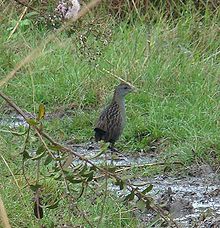Great Oʻahu crake
| Great Oʻahu rail Temporal range: Holocene
| |
|---|---|
Extinct (Early 11th century?)
| |
| Scientific classification | |
| Domain: | Eukaryota |
| Kingdom: | Animalia |
| Phylum: | Chordata |
| Class: | Aves |
| Order: | Gruiformes |
| Family: | Rallidae |
| Genus: | Porzana |
| Species: | †P. ralphorum
|
| Binomial name | |
| †Porzana ralphorum | |

| |
| Island of Oʻahu. | |
The great Oʻahu rail or great Oʻahu crake ("Porzana" ralphorum) is an extinct bird species from Oʻahu, Hawaiʻi, known only from subfossil bones. The holotype (USNM collection number 426114) is a right tarsometatarsus bone found in a flooded sinkhole on the ʻEwa Plain near Barbers Point, the southwestern tip of Oʻahu.[1]
It was known as the medium-large Oahu rail or medium flightless rail until its formal description,[2] to distinguish it from the other flightless rail species which was endemic on Oʻahu until after the arrival of humans. Traditionally placed in the "wastebin genus" Porzana, it almost certainly does not belong there, and its place in the rail family is effectively unknown as of 2023. Its scientific name honour C. John and Carol Pearson Ralph, who provided housing and other support for the scientists who found and described the species.[3]
Description and systematics[edit]

The great Oʻahu rail was the larger of two species of rail found on the island of Oʻahu. It was roughly the size of a Ash-throated crake or half again as large as the Hawaiian rail, about 20-25 cm (8-10 in) altogether, with a rather high and almost perfectly straight beak some 2 cm (slightly less than 1 inch) long, and weighing roughly 100 grams (3.5 oz). It was flightless due to its small wings – the entire arm, from fingertips to shoulder joint, was only about 6 cm (some 2 in) long, with the single known humerus about 10% larger in all dimensions than in the Great Maui crake which was similarly-sized and also flightless. The legs, on the other hand, were possibly slightly less well-developed as in the Maui species, with the holotype tarsometatarsus measuring 35.7 mm.[3]
The species' plumage is unattested, but most likely it had a brownish-greyish cryptic coloration – possibly almost blackish overall, or distinctly paler and greyer from the face downwards –, perhaps with some blackish or whitish spotting on the upperside and maybe a grey stripe over the eye – and probably with some extent of lighter vertical barring on the belly and maybe all the way to the neck, as is common among its putative relatives.[4]
It probably fed on the fruits, leaves, and flowers of trees that fell onto the ground. The cause of extinction is not very well known, but we can speculate that it was hunted for meat, and that its bones and feathers were used for decoration. It may also have been attacked by the Polynesian rats that were introduced by early settlers.
Additional specimens are known from the ancient Polynesian Niu shelter – possibly from a bird eaten by humans – at Kuliʻouʻou in East Honolulu on the central southern coast of Oʻahu, as well as Ulupaʻu Crater which juts out northwards from the Mokapu Peninsula at the island's southeastern tip.[5] No sites on northern Oʻahu or in the uplands have been studied; while it is nearly certain that the species once ranged all over Oʻahu's lowlands – Barbers Point being well distant form the other two sites, which in turn are connected only by a narrow strip of ground running around the Honolulu Volcanics mountain range – the extent to which it progressed into upland habitat is, as of 2023, not known at all.
Footnotes[edit]
References[edit]
- Garcia-R, Juan C. & Matzke, Nicholas J. (2021): Trait-dependent dispersal in rails (Aves: Rallidae): Historical biogeography of a cosmopolitan bird clade. Mol. Phylogenet. Evol. 159: 107106. doi:10.1016/j.ympev.2021.107106 PDF preprint
- James, Helen F. (1987): A Late Pleistocene avifauna from the island of Oahu, Hawaiian Islands. Documents des Laboratoires de Géologie de la Faculté des Sciences de Lyon 99(L'évolution des oiseaux d'après le témoignage des fossiles. Table ronde internationale du CNRS, Lyon-Villeurbanne, 18-21 septembre 1985): 221-230. PDF fulltext
- Olson, Storrs L. & James, Helen F. (1982): Prodromus of the fossil avifauna of the Hawaiian Islands. Smiths. Contrib. Zool. 365: 1-59. doi:10.5479/si.00810282.365 PDF fulltext
- Olson, Storrs L. & James, Helen F. (1991): Descriptions of Thirty-Two New Species of Birds from the Hawaiian Islands (Part I. Non-Passeriformes). Ornithol. Monogr. 45: 1-88. PDF fulltext
- Taylor, P. Barry & van Perlo, Ber (1998): Rails: a guide to the rails, crakes, gallinules, and coots of the world (Helm Identification Guides). Yale University Press, New Haven. ISBN 0-300-07758-0
